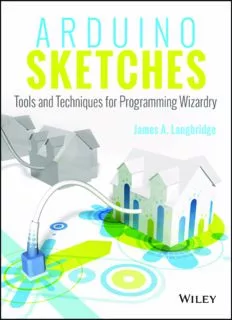Table Of ContentArduino Sketches
™
Arduino Sketches
™
Tools and Techniques for Programming
Wizardry
James A. Langbridge
Arduino™ Sketches: Tools and Techniques for Programming Wizardry
Published by
John Wiley & Sons, Inc.
10475 Crosspoint Boulevard
Indianapolis, IN 46256
www.wiley.com
Copyright © 2015 by John Wiley & Sons, Inc., Indianapolis, Indiana
Published simultaneously in Canada
ISBN: 978-1-118-91960-6
ISBN: 978-1-118-91962-0 (ebk)
ISBN: 978-1-118-91969-9 (ebk)
Manufactured in the United States of America
10 9 8 7 6 5 4 3 2 1
No part of this publication may be reproduced, stored in a retrieval system or transmitted in any form or
by any means, electronic, mechanical, photocopying, recording, scanning or otherwise, except as permitted
under Sections 107 or 108 of the 1976 United States Copyright Act, without either the prior written permis-
sion of the Publisher, or authorization through payment of the appropriate per-copy fee to the Copyright
Clearance Center, 222 Rosewood Drive, Danvers, MA 01923, (978) 750-8400, fax (978) 646-8600. Requests to
the Publisher for permission should be addressed to the Permissions Department, John Wiley & Sons, Inc.,
111 River Street, Hoboken, NJ 07030, (201) 748-6011, fax (201) 748-6008, or online at http://www.wiley
.com/go/permissions.
Limit of Liability/Disclaimer of Warranty: The publisher and the author make no representations or war-
ranties with respect to the accuracy or completeness of the contents of this work and specii cally disclaim all
warranties, including without limitation warranties of i tness for a particular purpose. No warranty may be
created or extended by sales or promotional materials. The advice and strategies contained herein may not
be suitable for every situation. This work is sold with the understanding that the publisher is not engaged in
rendering legal, accounting, or other professional services. If professional assistance is required, the services
of a competent professional person should be sought. Neither the publisher nor the author shall be liable for
damages arising herefrom. The fact that an organization or Web site is referred to in this work as a citation
and/or a potential source of further information does not mean that the author or the publisher endorses
the information the organization or website may provide or recommendations it may make. Further, readers
should be aware that Internet websites listed in this work may have changed or disappeared between when
this work was written and when it is read.
For general information on our other products and services please contact our Customer Care Department
within the United States at (877) 762-2974, outside the United States at (317) 572-3993 or fax (317) 572-4002.
Wiley publishes in a variety of print and electronic formats and by print-on-demand. Some material included
with standard print versions of this book may not be included in e-books or in print-on-demand. If this book
refers to media such as a CD or DVD that is not included in the version you purchased, you may download
this material at http://booksupport.wiley.com. For more information about Wiley products, visit
www.wiley.com.
Library of Congress Control Number: 2014948616
Trademarks: Wiley and the Wiley logo are trademarks or registered trademarks of John Wiley & Sons, Inc.
and/or its afi liates, in the United States and other countries, and may not be used without written permission.
Arduino is a trademark of Arduino, LLC. All other trademarks are the property of their respective owners.
John Wiley & Sons, Inc. is not associated with any product or vendor mentioned in this book.
To my loving girlfriend, Anne-Laure, who once again put up with entire evenings and
weekends spent on my PC. This is the second time I’ve done that to her, but she put
up with me anyway and kept on smiling (most of the time). I still don’t know how.
To my wonderful daughter, Eléna: I have to admit, I’m addicted to your laugh and
smile, something you did every time I showed you the projects I was working on.
Again you found a way of telling me when I needed to stop and spend more time
playing with you (by unplugging and randomly rewiring my breadboard projects),
but coming back home at the end of a long and difficult day to see you smiling and
jumping into my arms gave me more energy than you can imagine.
About the Author
James A. Langbridge does not like talking about himself in the third person,
but he will try anyway. James was born in Singapore and followed his parents
to several countries before settling down in Nantes, France, where he lives with
his partner and their daughter.
James is an embedded systems consultant and has worked for more than 15
years on industrial, military, mobile telephony, and aviation security systems.
He works primarily on low-level development, creating bootloaders or opti-
mizing routines in assembly, making the most of small processors. When not
on contract, James trains engineers on embedded systems, or he makes new
gizmos, much to the dismay of his partner.
James wrote his i rst computer program at age 6 and has never stopped tin-
kering since. He began using Apple IIs, ZX80s and ZX81s, and then moved to
BBC Micros and the Amiga before i nally having no other option but to use PCs.
vii
About the Technical Editor
Scott Fitzgerald is an artist and educator working with technology and its rela-
tionship to people, approaching digital tools from a human-centric perspective.
His work has been featured in numerous books and publications such as The
New York Times and IDN Magazine. He has edited several books on Arduino
and communication technologies, is the author of the book that accompanies
the Arduino Starter Kit, and is responsible for documentation of the Arduino
platform at http://arduino.cc. Scott is currently an assistant arts professor and
head of the interactive media program at New York University Abu Dhabi. He
enjoys tormenting his cat and partner with early morning work sessions.
ix

